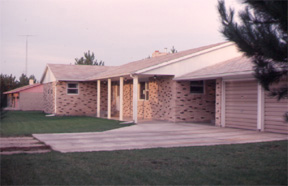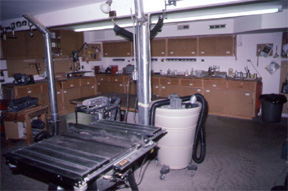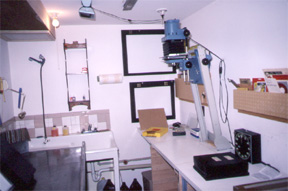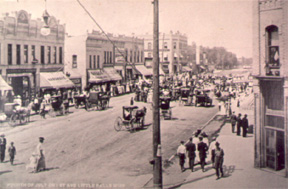Biographical Notes reCharles A. (Chuck) StonePage 2 of 3 Pages, of Chapter 12,A SECOND HOMECOMING |
|||||||
| Winter came and our work continued. With the loan of Norris’s mixer and space heater, we prepared to lay somewhere between 12,000 and 13,000 bricks in January, February and March of 1974. The pile of sand was in front of the house near a freeze free faucet on the side of the house. We had a culvert under the sand. We hung plastic sheeting over progressive parts of the house exterior and fired up the powerful space heater. In the early mornings, before breakfast, I would go out and start a fire in the culvert to warm the sand. Initially, under Norris’s direction, he, Sandie and I would pick our section of the enclosed area on which to lay our bricks. After mixing the mud out in the cold, we would pour it in the wheelbarrow and wheel it into the warm area and go to work. In spite of the cold, there were days when our work area was warmer than was the house, inside. Norris laid about 4,000 bricks, Sandie did about 4,000+ and I did about 4,000+. Norris left us to our work, once he was confident we had the hang of things. The day Sandie found her trowel nailed to the mortar board, by Norris, she knew she had passed the test. That was his official sign of approval. |
|||||||
As the house was becoming increasingly civilized, we needed a booster loan to move forward with our plan. With our initial cash and a moderate loan from the bank, we had come this far. The second loan permitted us to have carpeting installed where we needed it. We did the ceramic tile and vinyl installations ourselves. Having pots, pans and food in real cupboards and proper flooring underfoot, seemed a real luxury. |
|||||||
 |
|||||||
|
|
|||||||
| In the meantime, I had been checking out the teaching options in the local school. You will recall the Superintendent I had communicated with was long gone. It became obvious during our last semester at NAU that the hunt for new teachers had really slacked off. They had built and staffed a new High School in Little Falls a year before our return. The seated Superintendent told me all bets were off and he really didn’t show any interest in my participation in their affairs. I sensed he had an allergy to hiring military people. I could be wrong. To test the waters I took some substitution jobs, filling in for Industrial Education teachers that had to be somewhere else for a time. I found that popping in to take a class of Middle School children that swooped in and turned on all of the equipment in the place when I had little knowledge of who they were and no real clue as to their assignments or skill levels, was demeaning and inappropriate for my needs. I needed to be on the permanent staff or not at all. I withdrew my availability and assisted my brother-in-law in building a few houses. |
|||||||
| During this time I was completing the installation of my woodshop, photo lab and related facilities in the basement. Sandie, who had been assigned two rooms in the basement, established a pottery studio and we built a kiln house in back of the house so she could fire her work. Sandie began developing her formulas, procedures and practice to test the market to become a serious potter. From the start she had been shipped a ton of clay that was prone to have small explosions in the firing process. We discovered this was due to imperfections in the clay. She did some beautiful work, developed some remarkable glaze formulas, but soon realized that her dream was not commercially viable under existing conditions. After giving it a good test run, she evolved down to the University of Minnesota to study for a second degree, this time in Nursing. Although we missed the daily contact with Sandie, it didn’t take me long to expand my work to encompass the entire 2,000 square foot basement. |
|||||||
 |
|||||||
|
|
|||||||
 |
|||||||
|
|
|||||||
| Our settling in process included becoming a part of a combined Methodist and UCC Church that, by chance, was getting ready to build, from scratch. These two churches had combined in order to strengthen their ability to vacate two very old church buildings. The entire project was designed to include a lot of congregation hands-on participation. We joined in and I wonder, even today, why some of us were not killed swinging giant wood structural beams from railroad cars and into place or falling off an ice covered section of roof in the winter. While no project of this scope can be perfect, our church body and our remarkably hands-on, can-do, farm raised minister got the job done. As we got under cover, there was an extensive need for custom-designed cabinetry to go in the kitchen, narthex, work rooms, bathrooms, etc. I proposed to design, build and install these items over a period of time. I would charge for the materials, shop service and a moderate amount for labor. They agreed and with Nell’s help they were built and installed rather quickly. They are in place, yet today. At the same time, I had become involved in some community work relating to the creation of a formal Arts organization in the community and working with the Chamber of Commerce on a number of projects. In the summer of 1975 the construction of the Weyerhaeuser Memorial Museum, a County Historical Society facility, was nearing completion. They had a scheduled opening date, but the exhibit company they were contracted with in the Twin Cities could not perform in time to meet their opening date. They asked me if I could create most of their two dimensional exhibits in time for the opening. Having perfected my wet-mounting process, using acrylic materials, in Flagstaff, I suggested we do the same for their exhibits. They agreed, providing me with an extensive collection of photos that required copying, custom enlargement, and mounting on a proper base that could be mounted on the wall. |
|||||||
| We went into a maximum effort and turned over the exhibit materials for installation in time for their grand opening. That was a most satisfying experience. I was so pleased that my basement shop was finding so many ways to become a part of the pulse of the community. My day-to-day workload of picture framing, collage making, cabinet making, etc., furniture repair, continued for a number of years. The variety of work made every day an interesting, challenging and satisfying day. |
|||||||
 |
|||||||
|
|
|||||||
|
End of Page 2 of 3 Pages, Chapter 12 — Go to Page 3 Click below to select a destination Go to Page 1 — 2 — 3, this Chapter Chapters 1 — 2 — 3 — 4 — 5 — 6 — 7 — 8 — 9 — 10 |
|||||||